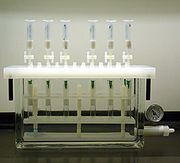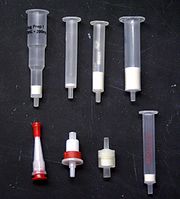
Solid phase extraction
Encyclopedia

Separation process
In chemistry and chemical engineering, a separation process, or simply a separation, is any mass transfer process used to convert a mixture of substances into two or more distinct product mixtures, at least one of which is enriched in one or more of the mixture's constituents. In some cases, a...
by which compounds that are dissolved or suspended in a liquid mixture are separated from other compounds in the mixture according to their physical and chemical properties. Analytical laboratories use solid phase extraction to concentrate and purify samples for analysis. Solid phase extraction can be used to isolate analytes of interest from a wide variety of matrices, including urine, blood, water, beverages, soil, and animal tissue.
SPE uses the affinity of solutes dissolved or suspended in a liquid (known as the mobile phase) for a solid through which the sample is passed (known as the stationary phase) to separate a mixture into desired and undesired components. The result is that either the desired analytes of interest or undesired impurities in the sample are retained on the stationary phase. The portion that passes through the stationary phase is collected or discarded, depending on whether it contains the desired analytes or undesired impurities. If the portion retained on the stationary phase includes the desired analytes, they can then be removed from the stationary phase for collection in an additional step, in which the stationary phase is rinsed with an appropriate eluent.
The stationary phase comes in the form of a packed syringe-shaped cartridge, a 96 well plate, a 47- or 90-mm flat disk, or a MEPS
Microextraction by packed sorbent
Microextraction by packed sorbent or MEPS is a miniaturised solid phase extraction technique for the purification and concentration of plasma, water, and other samples prior to analysis by techniques such as gas chromatography or high performance liquid chromatography. It should not be confused...
device, each of which can be mounted on its specific type of extraction manifold. The manifold allows multiple samples to be processed by holding several SPE media in place and allowing for an equal number of samples to pass through them simultaneously. A typical cartridge SPE manifold can accommodate up to 24 cartridges, while a typical disk SPE manifold can accommodate 6 disks. Most SPE manifolds are equipped with a vacuum port. Application of vacuum speeds up the extraction process by pulling the liquid sample through the stationary phase. The analytes are collected in sample tubes inside or below the manifold after they pass through the stationary phase.
Solid phase extraction cartridges and disks are available with a variety of stationary phases, each of which can separate analytes according to different chemical properties. Most stationary phases are based on silica that has been bonded to a specific functional group. Some of these functional groups include hydrocarbon chains of variable length (for reversed phase SPE), quaternary ammonium or amino groups (for anion exchange), and sulfonic acid or carboxyl groups (for cation exchange).
Normal Phase SPE procedure

A stationary phase of polar functionally bonded silicas with short carbons chains frequently makes up the solid phase. This stationary phase will adsorb polar molecules which can be collected with a more polar solvent.
Reversed phase SPE
Reversed phase SPE separates analytes based on their polarity. The stationary phase of a reversed phase SPE cartridge is derivatized with hydrocarbon chains, which retain compounds of mid to low polarity due to the hydrophobic effect. The analyte can be eluted by washing the cartridge with a non-polar solvent, which disrupts the interaction of the analyte and the stationary phase.A stationary phase of silicon with carbon chains is commonly used. Relying on mainly non-polar, hydrophobic interactions, only non-polar or very weakly polar compounds will adsorb to the surface.
Ion exchange SPE
Ion exchange sorbents separate analytes based on electrostatic interactions between the analyte of interest and the positively charged groups on the stationary phase. For ion exchange to occur, both the stationary phase and sample must be at a pH where both are charged.Anion exchange
Anion exchange sorbents are derivatized with positively charged functional groups that interact and retain negatively charged anions, such as acids. Strong anion exchange sorbents contain quaternary ammonium groups that have a permanent positive charge in aqueous solutions, and weak anion exchange sorbents use amine groups which are charged when the pH is below about 9. Strong anion exchange sorbents are useful because any strongly acidic impurities in the sample will bind to the sorbent and usually will not be eluted with the analyte of interest; to recover a strong acid a weak anion exchange cartridge should be used. To elute the analyte from either the strong or weak sorbent, the stationary phase is washed with a solvent that neutralizes the charge of either the analyte, the stationary phase, or both. Once the charge is neutralized, the electrostatic interaction between the analyte and the stationary phase no longer exists and the analyte will elute from the cartridge.Cation Exchange
Cation exchange sorbents are derivatized with functional groups that interact and retain positively charged cations, such as bases. Strong cation exchange sorbents contain aliphatic sulfonic acid groups that are always negatively charged in aqueous solution, and weak cation exchange sorbents contain aliphatic carboxylic acids, which are charged when the pH is above about 5. Strong cation exchange sorbents are useful because any strongly basic impurities in the sample will bind to the sorbent and usually will not be eluted with the analyte of interest; to recover a strong base a weak cation exchange cartridge should be used. To elute the analyte from either the strong or weak sorbent, the stationary phase is washed with a solvent that neutralizes ionic interaction between the analyte and the stationary phase.Further reading
E. M. Thurman, M. S. Mills, Solid-Phase Extraction: Principles and Practice, Wiley-Interscience, 1998, ISBN 978-0471614227Nigel J.K. Simpson, Solid-Phase Extraction: Principles, Techniques, and Applications, CRC, 2000, ISBN 978-0824700218
James S. Fritz, Analytical Solid-Phase Extraction, Wiley-VCH, 1999, ISBN 978-0471246671
Watch a slide show and learn Why Prepare a Sample.
Watch a slide show and learn about SPE Functional Groups.
Watch a slide show and learn Three Simple Steps to SPE.
Watch a slide show and video: Making an SPE Sample.
Watch a slide show and learn about SPE Sorbent and Cartridge Selection.

